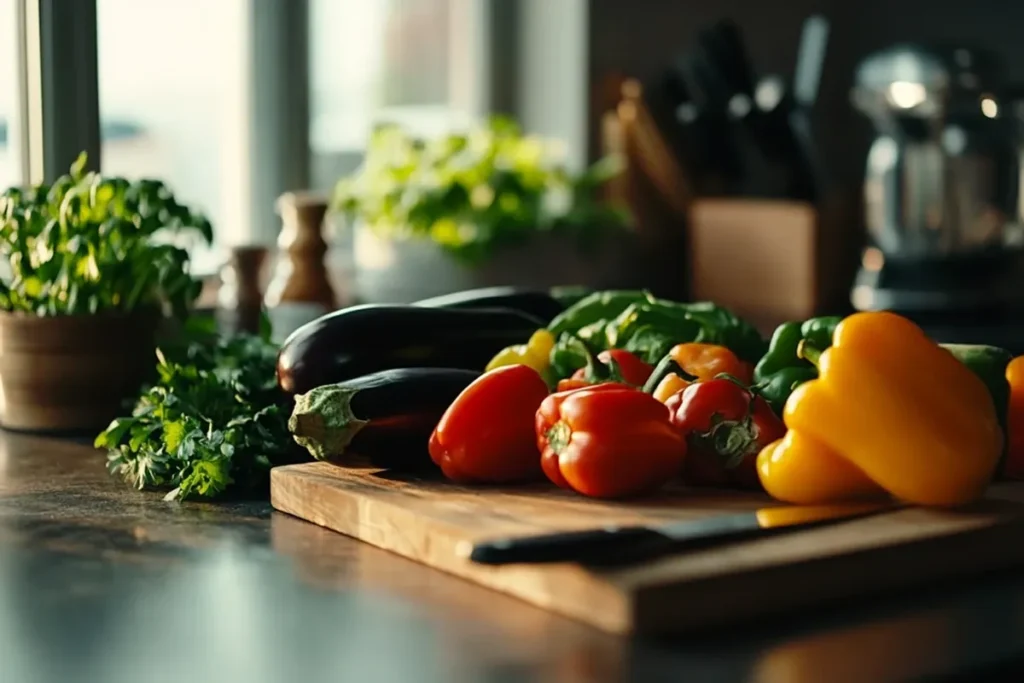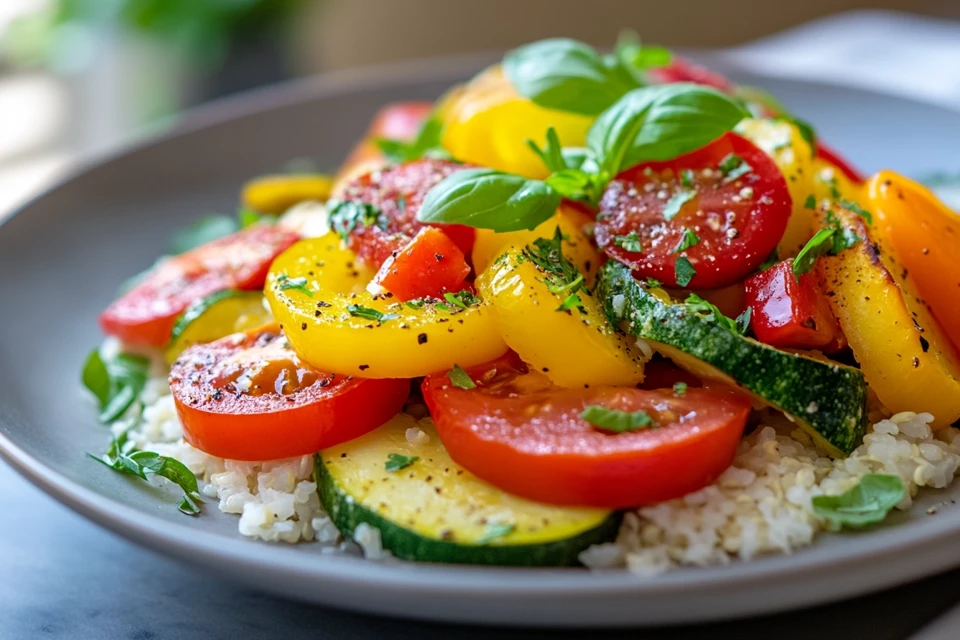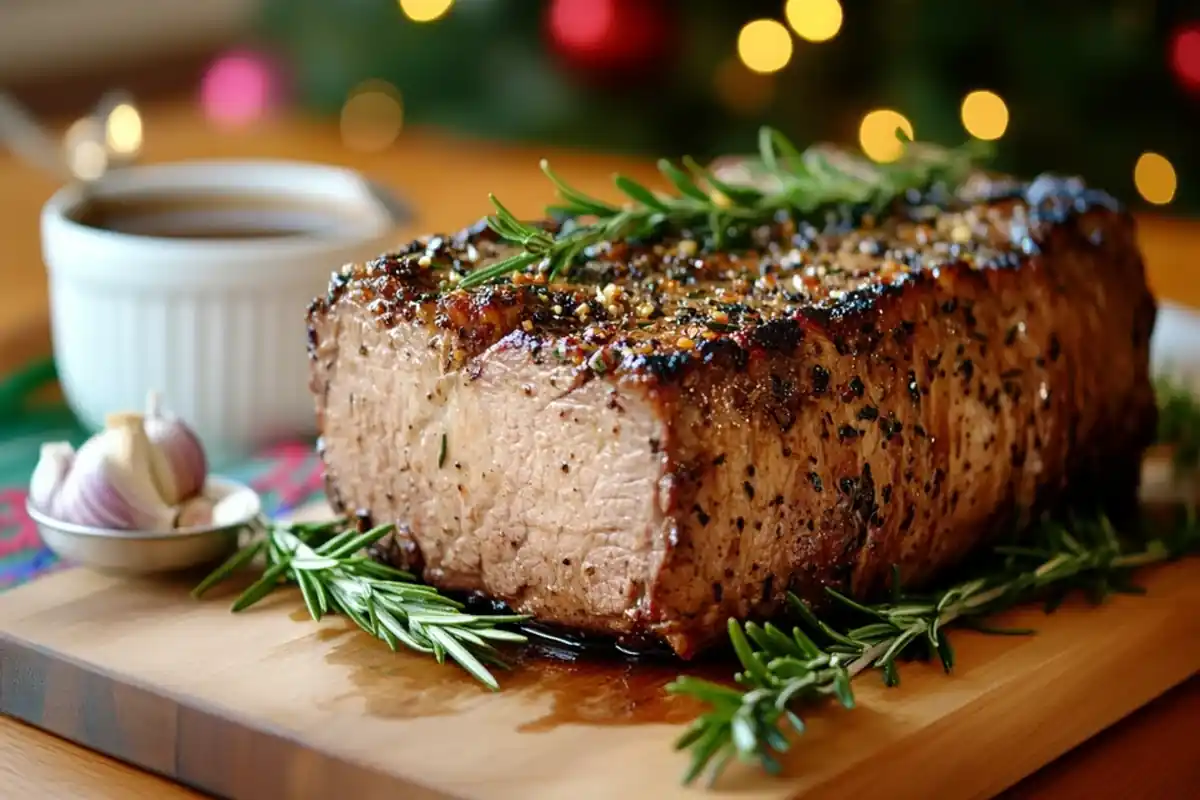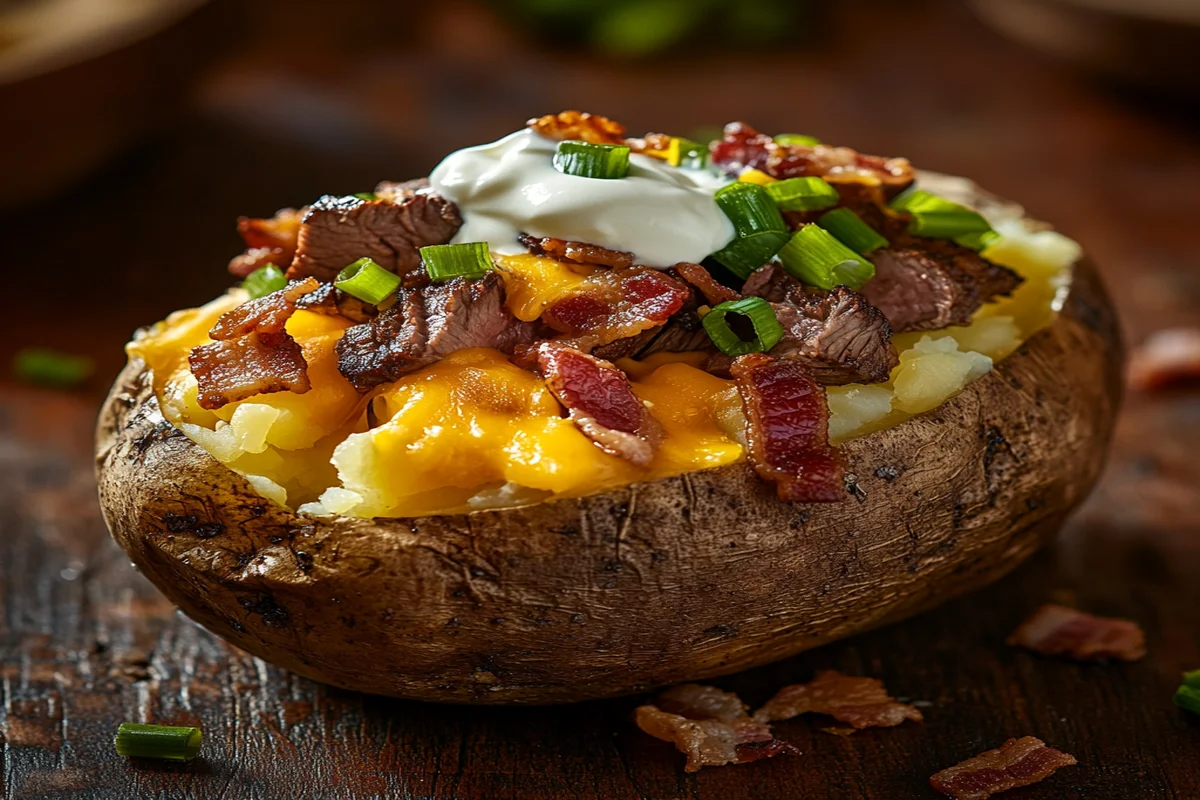Classic Ratatouille on Cauliflower Rice is a fusion of tradition and innovation. This delightful dish combines the rich flavors of a classic French vegetable stew with the modern twist of low-carb cauliflower rice. Whether you’re a culinary enthusiast or just exploring new ways to make healthy eating delicious, this guide will take you on a flavorful journey.
This article delves into the history of ratatouille, the nutritional benefits of cauliflower rice, and how to combine them into a show-stopping dish. You’ll also discover practical tips for preparation, serving suggestions, and more. Let’s dive in!
Introduction to Classic Ratatouille and Cauliflower Rice
Understanding Ratatouille: A French Culinary Staple
Ratatouille, pronounced “rat-a-too-ee”, is a beloved French vegetable stew that originated in the Provence region. This rustic dish showcases the bounty of the Mediterranean with its vibrant mix of eggplant, zucchini, tomatoes, and bell peppers. It’s flavored with aromatic olive oil, garlic, and fresh herbs, creating a simple yet elegant dish that has stood the test of time.
Traditionally, ratatouille was a peasant dish, designed to use up surplus summer vegetables. Over time, it has evolved into a culinary icon, celebrated for its versatility and wholesome flavors. Chefs worldwide have adapted it, creating variations ranging from baked casseroles to deconstructed gourmet plates. At its heart, ratatouille is about highlighting the natural flavors of fresh, seasonal produce.
Cauliflower Rice: A Modern, Low-Carb Alternative
In recent years, cauliflower rice has taken the health-conscious world by storm. This grain-free substitute offers the texture of traditional rice but with a fraction of the carbs and calories. Made by pulsing fresh cauliflower into tiny granules, it’s a simple yet ingenious way to incorporate more vegetables into your diet.
Why choose cauliflower rice for ratatouille? For one, it enhances the dish’s nutritional profile, packing in fiber, vitamins C and K, and antioxidants. Moreover, its neutral flavor provides the perfect canvas to soak up the rich tomato-based sauce of ratatouille. It’s also gluten-free, making it suitable for a wide range of dietary needs, from keto to paleo and beyond.
This winning combination of classic ratatouille on cauliflower rice not only satisfies your taste buds but also aligns with modern eating habits focused on wholesome, plant-based meals.
Preparing Classic Ratatouille

Fresh, colorful vegetables like eggplant, zucchini, and tomatoes for preparing ratatouille
Selecting Fresh Vegetables for Authentic Ratatouille
To create an authentic Classic Ratatouille on Cauliflower Rice, start with the freshest vegetables. Choosing high-quality produce ensures vibrant flavors and textures in your dish.
- Eggplant: Look for firm, glossy eggplants with smooth skin. They should feel heavy for their size, indicating freshness. Avoid any with soft spots or wrinkles.
- Zucchini: Select small to medium-sized zucchinis that are firm and free from blemishes. Their skin should be bright and taut.
- Bell Peppers: Opt for red, yellow, or orange bell peppers for a sweeter flavor. They should have firm, shiny skins without any soft spots.
- Tomatoes: Choose ripe, but firm tomatoes. Heirloom varieties can add depth to the dish. Their aroma should be fragrant, indicating ripeness.
- Onions and Garlic: Fresh onions and garlic are essential for building flavor. Ensure they are firm and free from sprouting.
Using quality olive oil and fresh herbs like thyme, rosemary, and basil elevates the dish. The olive oil adds richness, while the herbs provide aromatic notes that complement the vegetables.
Step-by-Step Ratatouille Recipe
Creating a delicious Classic Ratatouille on Cauliflower Rice involves careful preparation and layering of flavors.
Ingredient List:
- 1 large eggplant, diced
- 2 zucchinis, sliced
- 2 bell peppers, chopped
- 4 ripe tomatoes, diced
- 1 large onion, chopped
- 4 cloves garlic, minced
- 1/4 cup olive oil
- Fresh thyme and basil
- Salt and pepper to taste
Cooking Instructions:
- Prepare the Vegetables: Wash and cut all vegetables as specified. Pat them dry to remove excess moisture.
- Sauté the Onions and Garlic: In a large pan, heat olive oil over medium heat. Add chopped onions and sauté until translucent. Add minced garlic and cook for an additional minute.
- Add Eggplant: Incorporate diced eggplant into the pan. Cook until it begins to soften, stirring occasionally.
- Add Zucchini and Bell Peppers: Stir in sliced zucchinis and chopped bell peppers. Cook for about 5-7 minutes until they start to tenderize.
- Add Tomatoes and Herbs: Add diced tomatoes, fresh thyme, salt, and pepper. Stir well to combine. Lower the heat, cover the pan, and let it simmer for 20-25 minutes, stirring occasionally.
- Adjust Seasoning: Taste and adjust seasoning as needed. Before serving, garnish with fresh basil leaves.
Common Mistakes to Avoid When Making Ratatouille
Even with simple ingredients, certain pitfalls can affect the outcome of your Classic Ratatouille on Cauliflower Rice.
- Overcooking Vegetables: Overcooked vegetables become mushy, losing their distinct textures. To avoid this, monitor cooking times closely and aim for tender-crisp results.
- Undercooking Vegetables: Conversely, undercooked vegetables can be too firm and release excess moisture, diluting the sauce. Ensure each vegetable is cooked through but still retains some bite.
- Improper Layering: Adding all vegetables at once can lead to uneven cooking. Introduce them in stages based on their cooking times, starting with the ones that take longer.
- Insufficient Seasoning: Ratatouille relies on the natural flavors of vegetables, enhanced by seasoning. Taste throughout the cooking process and adjust salt, pepper, and herbs accordingly.
- Skipping the Simmering Step: Allowing the ratatouille to simmer lets the flavors meld together. Rushing this step can result in a less cohesive dish.
By paying attention to these details, you’ll create a flavorful and well-textured Classic Ratatouille on Cauliflower Rice.
Preparing Cauliflower Rice
How to Make Cauliflower Rice at Home
Creating cauliflower rice at home is straightforward and allows you to control its texture and freshness.
Tools Needed:
- Food processor or box grater
- Sharp knife
- Clean kitchen towel or paper towels
Preparation Guide:
- Select Fresh Cauliflower: Choose a firm, white cauliflower head without blemishes.
- Wash and Dry: Rinse the cauliflower thoroughly under cold water. Pat it dry to remove excess moisture.
- Remove the Core: Using a sharp knife, cut the cauliflower into quarters and remove the central core. Break the quarters into smaller florets.
- Grate the Cauliflower: Place the florets in a food processor and pulse until they resemble rice grains. Alternatively, use a box grater to achieve the same texture.
- Remove Excess Moisture: Transfer the riced cauliflower onto a clean kitchen towel or paper towels. Press gently to absorb any remaining moisture.
Cooking Techniques for Perfect Cauliflower Rice
Proper cooking methods ensure that your cauliflower rice complements the Classic Ratatouille perfectly.
Sautéing Method:
- Heat a Pan: Place a large skillet over medium heat and add a tablespoon of olive oil.
- Add Cauliflower Rice: Once the oil is hot, add the prepared cauliflower rice to the pan.
- Cook: Sauté for 5-7 minutes, stirring occasionally, until the cauliflower is tender but not mushy.
- Season: Add salt and pepper to taste. For added flavor, consider incorporating minced garlic or a squeeze of lemon juice.
Steaming Method:
- Prepare a Steamer: Fill a pot with a small amount of water and bring it to a boil. Place a steamer basket over the pot.
- Add Cauliflower Rice: Place the cauliflower rice in the steamer basket.
- Steam: Cover and steam for 3-5 minutes until tender.
- Season: After steaming, transfer the rice to a bowl and season as desired.
Flavoring Options:
- Herbs: Fresh parsley or cilantro can add a burst of freshness.
- Spices: A pinch of cumin or turmeric can introduce warm, earthy notes.
- Cheese: For a richer taste, sprinkle grated Parmesan over the cooked rice.
By mastering these preparation and cooking techniques, your Classic Ratatouille on Cauliflower Rice will be both delicious and satisfying.
Serving and Pairing Suggestions

Plating Classic Ratatouille on Cauliflower Rice
Presentation plays a crucial role in elevating your Classic Ratatouille on Cauliflower Rice. To begin, spoon a generous portion of cauliflower rice onto the center of each plate. Next, artfully arrange the ratatouille over the rice, allowing the vibrant colors of the vegetables to stand out. For an added touch, garnish with fresh basil leaves or a sprinkle of chopped parsley. This not only enhances the visual appeal but also adds a burst of fresh flavor. Additionally, drizzling a bit of high-quality olive oil or balsamic glaze can provide a glossy finish and depth to the dish.
Wine and Beverage Pairings
Selecting the right beverage can enhance the dining experience. For wine enthusiasts, a light-bodied red wine like Pinot Noir complements the earthy flavors of the ratatouille without overpowering the dish. Alternatively, a crisp white wine such as Sauvignon Blanc offers a refreshing contrast to the rich vegetable medley. For those preferring non-alcoholic options, consider serving a sparkling water infused with lemon or a chilled herbal tea like mint or chamomile. These choices cleanse the palate and harmonize with the meal’s flavors.
For more delicious recipes, check out our recipe article.
Health Benefits and Dietary Considerations
Nutritional Profile of Ratatouille and Cauliflower Rice
Combining ratatouille with cauliflower rice results in a nutrient-dense meal. Ratatouille, rich in a variety of vegetables, provides essential vitamins such as A and C, along with dietary fiber that supports digestive health. The inclusion of olive oil contributes healthy monounsaturated fats, beneficial for heart health. Cauliflower rice, on the other hand, is low in calories and carbohydrates, making it an excellent alternative for those monitoring their carb intake. It’s also a good source of vitamin K and folate, supporting bone health and cellular function.
Accommodating Dietary Restrictions
This dish is inherently versatile, catering to various dietary needs. It’s naturally vegan and gluten-free, suitable for those avoiding animal products or gluten. For individuals following a ketogenic or low-carb diet, the substitution of traditional rice with cauliflower rice aligns with their nutritional goals. If there are concerns about specific ingredients due to allergies or personal preferences, consider the following substitutions:
- Nightshade Allergies: Replace tomatoes and bell peppers with zucchini or mushrooms to maintain texture and flavor.
- Herb Preferences: If fresh basil isn’t available, fresh thyme or oregano can be used as alternatives.
By being mindful of these considerations, Classic Ratatouille on Cauliflower Rice can be enjoyed by a wide audience, accommodating various health goals and dietary restrictions.
Frequently Asked Questions (FAQs)
What is traditionally served with ratatouille?
Ratatouille is incredibly versatile and pairs well with a variety of dishes. Traditionally, it’s served with crusty French bread or alongside protein options like roasted chicken or grilled fish. However, pairing it with cauliflower rice creates a healthy, low-carb option that’s just as satisfying. This combination allows the vegetables’ rich flavors to shine without competing with heavy sides.
What is the original ratatouille?
The original ratatouille hails from the Provence region of France, where it was a simple, rustic dish made to utilize abundant summer vegetables. Its core ingredients typically include eggplant, zucchini, tomatoes, and bell peppers, cooked slowly with olive oil and herbs like thyme and basil. Today’s variations, such as Classic Ratatouille on Cauliflower Rice, retain the essence of this traditional dish while offering modern, health-conscious twists.
Can I use cauliflower rice like regular rice?
Yes, cauliflower rice is an excellent substitute for regular rice in many recipes. It’s especially great for dishes like Classic Ratatouille on Cauliflower Rice, where it absorbs the stew’s flavorful sauce while keeping the meal light and nutritious. Just ensure you cook it correctly—sautéing or steaming works best to maintain its texture.
What is the secret of a good ratatouille?
The secret to a delicious ratatouille lies in the quality of its ingredients and the cooking process. Fresh, in-season vegetables are key to achieving the dish’s signature flavors. Additionally, cooking the vegetables in layers ensures they retain their distinct textures and flavors. A slow simmer allows the herbs and olive oil to meld with the vegetables, creating a cohesive and aromatic dish.
Tips for Customizing Classic Ratatouille on Cauliflower Rice
Experimenting with Vegetables and Seasonings
One of the best things about Classic Ratatouille on Cauliflower Rice is its adaptability. While traditional recipes rely on eggplant, zucchini, and tomatoes, you can customize the dish with other vegetables like mushrooms, squash, or even kale. These substitutions can add variety and suit seasonal availability.
For those who enjoy experimenting with flavors, consider introducing spices such as smoked paprika or cumin. These can provide a unique twist to the dish while complementing the natural sweetness of the vegetables.
Enhancing the Cauliflower Rice Base
Although plain cauliflower rice works well, you can easily elevate its flavor to match the richness of ratatouille. For example:
- Sauté the cauliflower rice with minced garlic and a splash of olive oil.
- Stir in fresh herbs like parsley or chives for a burst of freshness.
- Add a squeeze of lemon juice or a pinch of zest to brighten the dish.
By customizing the cauliflower rice, you create a more balanced and flavorful pairing for the ratatouille.
Adding Protein for a Complete Meal
While Classic Ratatouille on Cauliflower Rice is satisfying on its own, adding a protein source can transform it into a hearty main course. Options like grilled tofu, poached eggs, or sautéed shrimp complement the dish without overwhelming its delicate flavors. For a plant-based twist, consider topping the dish with roasted chickpeas for added texture and protein.
By tailoring this recipe to your taste, you can create a meal that is not only delicious but also uniquely yours.
Storing and Reheating Classic Ratatouille on Cauliflower Rice
Proper Storage for Maximum Freshness
Storing your Classic Ratatouille on Cauliflower Rice correctly is key to preserving its flavors and textures. Allow the dish to cool completely before transferring it to airtight containers. Separating the ratatouille from the cauliflower rice helps maintain the rice’s texture during storage. Both components can be stored in the refrigerator for up to 3-4 days.
If you plan to keep it longer, freezing is a great option. Place the ratatouille and cauliflower rice in freezer-safe containers or bags, making sure to remove as much air as possible. Label each container with the date for easy tracking. Frozen ratatouille can last up to three months, while cauliflower rice is best consumed within a month for optimal texture.
Reheating Tips for the Best Results
Reheating Classic Ratatouille on Cauliflower Rice requires a gentle approach to maintain the dish’s integrity. For the ratatouille, use a saucepan over low heat, stirring occasionally to prevent sticking. Add a splash of water or broth if it seems too thick.
For the cauliflower rice, reheat in a skillet over medium heat, stirring frequently to keep it fluffy. Avoid microwaving the cauliflower rice as it can become mushy. When combining the two, warm each component separately before plating to ensure both are heated evenly.
By following these tips, you can enjoy this dish just as much the second or third time around.
Why Classic Ratatouille on Cauliflower Rice is a Perfect Meal Choice
Health Benefits and Flavor Harmony
Classic Ratatouille on Cauliflower Rice is more than just a recipe; it’s a perfect balance of flavor and nutrition. The vibrant vegetables in ratatouille offer a powerhouse of vitamins, antioxidants, and fiber, supporting everything from heart health to better digestion. Pairing it with cauliflower rice adds a low-calorie, nutrient-dense base, making this dish ideal for those seeking a lighter, healthier meal option.
This combination not only satisfies your taste buds but also aligns with modern dietary preferences. Whether you’re following a gluten-free, vegan, or low-carb lifestyle, this dish fits seamlessly into your menu. Plus, its flexibility allows you to adjust ingredients and seasonings to suit your unique needs.
A Sustainable and Budget-Friendly Option
Preparing Classic Ratatouille on Cauliflower Rice is not just good for your health—it’s also a sustainable choice. By focusing on fresh, seasonal vegetables and a homemade rice alternative, you reduce your reliance on processed foods and packaging. This not only benefits the environment but also keeps your grocery bills in check.
Additionally, this recipe makes excellent use of ingredients you may already have on hand. For example, leftover cauliflower can be easily transformed into rice, while slightly overripe tomatoes are perfect for the ratatouille base. With a little planning, this dish helps you minimize food waste while delivering maximum flavor.
By choosing Classic Ratatouille on Cauliflower Rice, you’re opting for a meal that’s healthy, delicious, and mindful of both your budget and the planet.
Storing and Reheating Classic Ratatouille on Cauliflower Rice
Proper Storage Techniques
To enjoy your Classic Ratatouille on Cauliflower Rice for days to come, proper storage is essential. First, allow the dish to cool to room temperature. Then, transfer the ratatouille and cauliflower rice into separate airtight containers. Storing them separately helps maintain the cauliflower rice’s texture and prevents it from becoming soggy.
- Refrigeration: Place the containers in the refrigerator and consume within 3-4 days for the best flavor and freshness.
- Freezing: For longer storage, freeze the ratatouille and cauliflower rice in individual portions. Use freezer-safe bags or containers, ensuring all air is removed before sealing. Frozen ratatouille can last up to three months, while cauliflower rice is best used within one month for optimal texture.
By separating and properly storing the components, reheating is easier and more effective, keeping your dish delicious and fresh.
Best Practices for Reheating
When reheating Classic Ratatouille on Cauliflower Rice, preserving the flavor and texture is key. Here’s how:
- Ratatouille: Reheat on the stove over low heat, stirring occasionally to ensure even warming. If the sauce has thickened, add a splash of water or vegetable stock to loosen it.
- Cauliflower Rice: Use a skillet to reheat the rice over medium heat. Stir frequently to maintain its fluffy texture and avoid overcooking, which can make it mushy.
Avoid reheating the components together to maintain the integrity of the dish. For the best results, reheat each part separately and combine them just before serving.
Why Classic Ratatouille on Cauliflower Rice is a Perfect Meal Choice
A Nutritious and Flavorful Option
Classic Ratatouille on Cauliflower Rice is a powerhouse of nutrition and taste. The vegetable-rich ratatouille provides an abundance of vitamins, antioxidants, and fiber, making it an excellent choice for supporting a balanced diet. Meanwhile, the cauliflower rice base adds a low-calorie, low-carb twist, perfect for those who want to enjoy a hearty meal without overindulging.
This dish also caters to a variety of dietary preferences. It’s naturally vegan, gluten-free, and keto-friendly, making it a go-to option for almost anyone. Plus, its wholesome ingredients and lack of processed components ensure it’s as healthy as it is delicious.
A Versatile and Economical Choice
Another reason why Classic Ratatouille on Cauliflower Rice shines is its adaptability. You can customize it with seasonal vegetables or adjust the spices to match your taste preferences. Whether you want to add a pinch of chili flakes for heat or use smoked paprika for depth, the options are endless.
From a practical standpoint, this recipe is budget-friendly. Fresh, simple ingredients like zucchini, tomatoes, and cauliflower are often inexpensive and readily available. Plus, it’s a fantastic way to use up produce that might otherwise go to waste, making it both cost-effective and environmentally conscious.
By choosing Classic Ratatouille on Cauliflower Rice, you’re not just enjoying a flavorful dish—you’re also making a nutritious, versatile, and sustainable meal choice that benefits both your health and your wallet.

